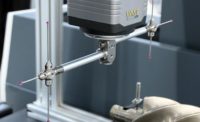The 21st century has seen aerospace parts manufacturers soaring to new heights of improved fuel consumption and lighter parts while lowering costs. Aerospace part designers have focused on turbine blades and blisks. These critical parts are being progressively adjusted and experimented on to increase thrust and gain better fuel efficiency while maintaining high-volume, high-speed production.
How can aerospace parts manufacturers meet demands for lightweight, precise parts and components that are durable and temperature-resistant while complying with stringent regulatory requirements? High-quality aerospace parts need high-quality industrial metrology solutions.
Quality inspection plays a critical role in assessing the effectiveness and consistency of innovation in aerospace part production. To keep up with the competitive pace of production, aerospace manufacturers need to implement high-speed scanning with coordinate measuring machines (CMMs) on the production floor without sacrificing maximum accuracy.
Aerospace Is A Hotbed Of Innovation
The aerospace parts manufacturing industry encompasses a broad range of sectors, including aircraft, spacecraft, rocket and missile systems for defense, propulsion systems, aircraft engines and more. As further weight reduction and higher-efficiency engines can improve fuel consumption, many aerospace manufacturers continuously seek more agile R&D, engineering, sourcing and producing parts for end-use applications.
"The aerospace and defense industry continues to be a hotbed of innovation, with activity driven by the uptake of advanced technology, and growing importance of technologies such as hypersonics and advanced materials," explains NavalTechnology magazine.
Developments of novel materials such as superalloys as well as advances in design and manufacturing technology have been essential for this expanding and ever-evolving industry. Turbine blades and blisks are two of the key parts that have thrived from this push for superior technological and human expertise.
Turbine blades are important components in the gas turbine engine. Quality solutions need to be capable of accommodating demanding dimensional tolerances. | Image Source: ZEISS
Turbine Blades And Blisks — Crucial For Jet Engine Performance And Efficiency
Turbine blades are small, yet important components in the gas turbine engine. Airflow over turbine blades affects the amount of thrust produced and overall efficiency of the engine and aircraft. They operate in extreme environments at high-temperature conditions that can cause catastrophic failure from melting or oxidizing.
Absolute perfection is imperative for these parts, as air travel is expected to double in volume over the next decade, says Texas A&M University’s Engineering department.
Blisks are single components comprising a rotor disk and multiple curved blades. According to Production Engineering Solutions magazine, "Blisks play an important role in minimizing drag and optimizing airflow in the engine and the amount of thrust it produces."
Blisks substantially reduce component counts, increase reliability and maximize engine efficiency. The successful manufacturing of these safety-critical parts combines challenging part geometry, heat-resistant materials and refined processes — all lifted up by powerful quality solutions.
Easy preparation of measurement plan and processing of results in ZEISS CALYPSO and the ability to output customer-specific airfoil analysis software file formats directly. | Image Source: ZEISS
Unique Challenges Of Measuring Turbine Blades And Blisks
Safety is the first thing that should pop into your head when thinking of planes and spacecraft. These vehicles are built to withstand high impacts, temperature fluctuation and stress throughout their lifecycles. Building flexible components that are resistant yet lightweight in order to function without incident is paramount.
Acknowledging that modern aircraft engines are masterpieces of engineering, their constantly increasing requirements for performance and fuel efficiency pose complex challenges for aerospace manufacturers. To guarantee error-free parts, these quality gates must be overcome:
- Turbine blades and blisks have multiple characteristics that must be quantified versus requirements, with possible qualification techniques including both contact and noncontact.
- The aerospace industry has several high-quality systems and performance standards, such as AS9100. This standard is intended to establish a single quality management system for use within the aerospace industry, says NSF.
- Expensive and time-consuming manufacturing processes due to the required precision and fine milling process, says Production Engineering Solutions.
- Any surface or dimensional imperfection can cause blade and ultimately engine failure.
- Increasingly intricate and harder-to-measure turbine blade designs incorporate new geometries and different composites and castings.
- Specific fuel consumption, noise or weight reductions.
- Industry 4.0, connected data, operational excellence and digital twin capabilities.
Easy preparation of measurement plan for measurements in ZEISS CALYPSO, using rotary table and software simulation for simpler programming methods. ZVR and ZVRA software options allow for parameter optimization to achieve the quickest cycle time while maintaining measurement result integrity. | Image Source: ZEISS
Shopfloor CMM Solutions Speed Up Measurement Without Compromising Accuracy
Quality solutions need to be capable of accommodating demanding dimensional tolerances of blades and blisks. Robust inspection systems should have high-speed, high accuracy scanning capabilities that can keep pace with increased production, according to Aerospace Magazine.
To soar above the rest, aerospace manufacturers need metrology solutions that combine contact and noncontact sensors while optimizing workpiece and probe positioning. These CMM solutions can produce even faster results if they are out of the metrology lab and on the shop floor.
Quality assurance performed at the site of production can identify and possibly even avoid manufacturing errors. At-line and inline inspection offers the advantage of shortening measurement times and operating costs. Adding technology and accessories like rotary tables, leading-edge controllers and specialized blade software speeds up the inspection process.
Optimized Measurement Technology For Aerospace Parts
New CMM inspection technology has the ability to operate at temperatures up to 40°C which enables the CMM to be integrated in a production area without an additional investment in a temperature-controlled measuring enclosure. One Midwest aerospace parts manufacturer now uses that CMM with its integrated RT-AB rotary table and safety features. These functionalities have allowed this aerospace parts manufacturer almost unlimited flexibility in gathering data when inspecting engine components and finding defects.
Conclusion
Any means of speeding up the measurement process without compromising on accuracy promises significant savings for the aerospace parts manufacturing sector at large. It’s possible to increase the speed and power of your production processes without losing speed and quality on the shop floor.

